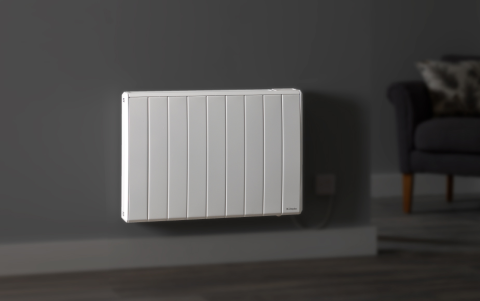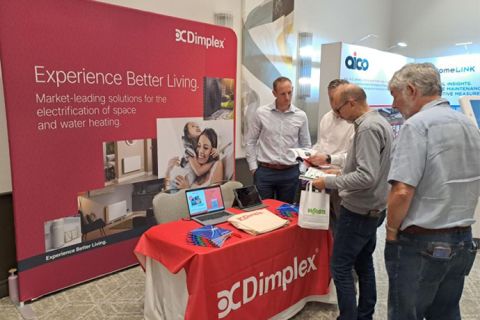
Project 80
Project 80 delivers 12 affordable homes built to the Future Homes Standard three years before it comes into force, achieving at least an 80% carbon emissions reduction within each unit. Fully electric heat pump solution with The Edel hot water heat pump at heart was selected for two units in this ground breaking development.
See how specification of Edel hot water heat pump with Monterey MFPE direct acting panel heaters helped achieve 80% carbon emission reductions and provide the occupants with a hot water and space heating solution that provides thermal comfort efficiently and is easy to control.
Project 80, Midland Heart
-
PDFDimplex - Case Study - Project 80Download
Project 80 – The first social housing development built to the Future Homes Standard
The first phase of Project 80 delivers 12 affordable homes built to the Future Homes Standard, three years before it comes into force, achieving at least an 80% carbon emissions reduction within each unit. The pioneering multiphase development is a 100% affordable rent project by social housing provider Midland Heart Ltd. Project 80 incorporates a host of innovative building products and technologies.
As the leaders in the development and manufacture of electric heating solutions with a history of regulatory expertise, Dimplex, part of Glen Dimplex Heating & Ventilation, were awarded plots three and four of Project 80. These were developed into two-bedroom, two-storey homes with fully-electric hot water and space heating solutions that feature the innovative Edel hot water heat pump and Monterey MFPE direct acting panel heater, by Dimplex, at their hear.
The site had been in the planning process since 2016, but in 2020 Midland Heart decided to drive a change and build the homes on this site differently. Tony Hopkins, Head of Construction and Quality at Midland Heart, explains why: “We became aware of the Future Homes Standard in 2019, and it quickly became clear that by 2025 there will be a significant change to the way we work and how we develop houses. More importantly, the way people live in these houses will also change. We decided to spend the next five years researching and understanding the implications of the necessary changes.”
The appearance of the houses is that of conventional masonry construction, but behind the traditional facade are innovative construction methods, materials and technologies that made the necessary 80% carbon emission reduction possible.
The design of each of the homes and the installed technologies differ. For hot water and space heating delivery, some homes use hot water heat pumps and direct acting panel heaters, while others utilise a variety of air source heat pumps (ASHPs), unvented water cylinders, and wet distribution systems. This variety of solutions is to offer metrics on the performance and useability of the used solutions and the homes as a whole. Each dwelling was holistically designed and the different building elements were selected to work in harmony with the heating, hot water and ventilation technology specified.
Changes to the thermal efficiency of the building fabric, and air permeability, pave the way for efficient low-carbon heating and hot water technologies
The high-performance building fabric required a change to the insulation of the external walls. The flooring and roofing specification remain largely unchanged from that of a standard building, but the external wall’s U-value was improved from 0.2 to 0.13. This was achieved with a 150mm cavity filled with Xtratherm Cavity Therm Insulation. Superior double-glazed units were specified, improving the U-value from 1.4 to 1.2. The g-values vary and reflect the potential of some plots to overheat, as identified using the CIBSE TM59 overheating analysis.
Air permeability was another performance benchmark that Midland Heart wanted to explore further. Each of the 12 properties has a different level of airtightness to reflect the variety of modelling options in the Future Homes Standard. The two units that feature Dimplex low-carbon technologies used polymer spray over the H+H Aircrete blockwork to achieve an airtightness of 1.5 instead of the 5.0-6.0 that is common in similar types of properties currently. Mechanical Ventilation with Heat Recovery was specified to ensure each home is sufficiently ventilated to provide occupants with a balance of energy performance and comfort.
Innovative heating and hot water technologies by Dimplex helped deliver the planned 80% carbon emission reduction
Tony Hopkin explains the rationale behind the solution specification based on Dimplex hot water heat pumps: “We are looking at the most user-friendly way to deliver regulations. Both the ASHPs and this fully-electric heat and hot water solution by Dimplex can deliver 80% CO2 reduction. We are keen to learn how residents get on with these technologies.”
The hot water heat pump solution specified for plots three and four feature the 200l Edel hot water heat pump and Monterey MFPE direct acting panel heaters. This is complemented with a PV panel installation.
The hot water heat pump delivers the service for the highest energy demand: domestic hot water. Its high coefficient of performance (COP) of over 3.36 ensures high energy-efficiency. In terms of space, the internally installed air source heat pump is integrated within a 200l hot water cylinder that fits into a standard service cupboard. Unlike many low-carbon solutions, installing the ducted hot water heat pump doesn’t require a specialist installer.
The Monterey MFPE panel heaters provide space heating with relatively low-energy demand in highly insulated properties. Waste water heat recovery was installed in all properties to utilise the heat from the water that goes through the soil stack, and preheat the water going into the various systems that incorporate heat pump technologies. Tony explains the reasons for this: “We are exploring different approaches, and we are learning what works. This will inform which technologies we include and which we can take away and still achieve compliance. We are also learning which compliant technologies work for our residents. If we find that people get on better with a Future Homes Standard compliant system that includes panel heaters rather than one based on an ASHP, we can adopt that methodology in 2025.”
Are apps the way forward for compliance, and do smart controls improve user experience?
Controllability is a crucial feature technology for Midland Heart as it directly affects the occupant experience. Tony adds: “Direct acting panel heaters give occupants more control over their thermal comfort. We are exploring anecdotal evidence that some occupants do not get on well with technologies that do not allow for direct control, which is the case with some ASHPs. This may create challenges in terms of energy-efficient operation that could result in unexpected energy bills.”
The Monterey MFPE panel heater has a host of intelligent features to maximise the efficiency of space heating delivery. Open window detection limits energy wasted by automatically reducing the target room temperature if the integrated sensors detect a sudden room temperature change. Adaptive start technology monitors the room temperature to understand the needs of the room and postpone heating as necessary. The Dimplex Control app integrates both the hot water heat pump technology and direct acting panel heaters via radio frequency (RF) at 868 Hz. There is no impact on the Wi-Fi, and it provides a greater communication range for completely convenient, wireless control by the occupier.
The 2021 updates to Approved Document L introduce the new BREL (Building Regulations Part L) Compliance Report and photographic evidence of critical building installations. These measures confirm the installation of correct elements and sufficient quality workmanship to support the values entered into SAP calculation for the dwelling.
Tony confirms that Midland Heart thought of this: “We work with a company called Captego who already have a site inspection app. We are looking at ways of integrated site photography and adding this to the versions of the building.” The benefits of this can go beyond compliance and help occupiers use the technology in their dwellings better. Tony continues: “We are trying to eradicate the infamous folders you receive with a new home. They are full of guides and certificates but are not the easiest to interact with. In cooperation with Covatech, we are developing an app that will allow residents, through augmented reality, to walk through the property to look at the different elements to receive information and videos on how to use them. We would like to link the two apps to give users all the necessary information. This is in a concept stage."
What is next for Project 80?
Project 80 brings together a host of manufacturers of sustainable technologies; Tricas, local building contractors, and The Building Alliance, are also part of the research and development project. Mike Leonard, the CEO of The Building Alliance, and visiting professor at Birmingham City University, sums up the approach: “This is an end-to-end journey. It includes manufacturers, house builders, designers, energy assessors, architects, contractors, subcontractors, M&E engineers and building controllers. Everyone shares in this journey. We need to stop working in silos. We all share a desire to deliver homes built for the future.” He continues to explain the objectives of the research side of Project 80: “With spiralling energy costs, it is important to us that we deliver systems that are cost effective for the occupier. With all our research into construction materials, techniques and how the building performs, as well as relevant data collection, we will also run financial rules across the project. We want to understand the difference in the cost of the bills of new homes vs the 2013 regulations. And importantly, the cost of running the different homes with building fabric that performs the same but with different systems installed. We want to be able to compare these directly.”
Once the project is finished, academic researchers from the Birmingham City University (BCU) will collate the post-occupancy data to inform the forthcoming Government-led technical consultation on the Future Homes Standard. The research part of the project will include studies into user behaviours, and engagement with the residents will add a sociology perspective. The impartial report by BCU will include indoor air quality (IAQ), overheating and energy performance. Tony explains that Midland Heart is keen to ensure academic rigour and impartiality for all the studies; “I am aware that we could make errors. We will also learn lessons from these. We will publish these to ensure the industry does not replicate them.”
Jonathan Jennings, Chief Business Development Officer at Dimplex, seconds this: “Dimplex is excited to have been part of this unique project that will help inform future regulations. We firmly believe that building successful zero-carbon-ready homes lies in collaboration and we are proud to have shared our expertise alongside others in industry to understand what these homes may look like. We will need a range of innovative technologies to meet our future targets and we hope that our contribution shows that an electric space heater and hot water heat pump is one solution that can aid us in the transition to sustainable homes.”











